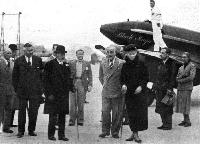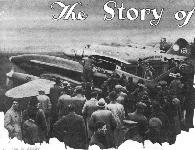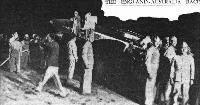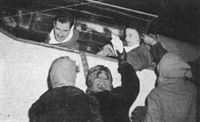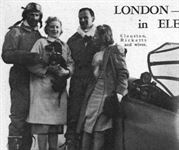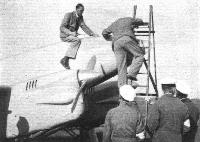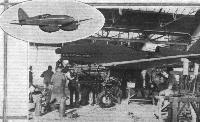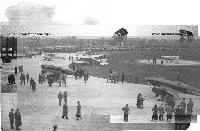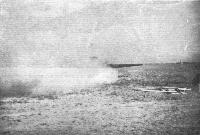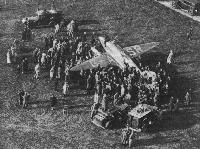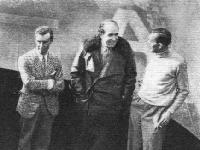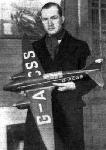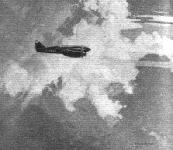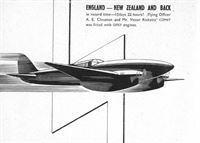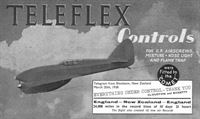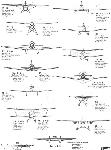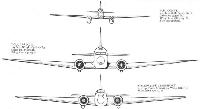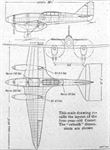
Варианты
- De Havilland - Comet / D.H.88 - 1934 - Великобритания
- Caudron - C.640 Typhoon - 1935 - Франция
de Havilland DH.88 Comet
Самолет DH.88 Comet был разработан специально для гонок 1934 года между Милденхоллом и Мельбурном, приуроченным к столетию австралийского штата Виктория, спонсором которых был сэр Макферсон Робертсон. К февралю 1934 года - сроку окончания приема заявок и заказов - были получены три заявки. Покупателями были А. О. Эдвардс, владелец отеля "Grosvenor House", Бернар Рубин, а также супруги Моллисон, Джим и Эми (в девичестве Джонсон). Comet имел цельнодеревянную конструкцию. В передней части были установлены три больших топливных бака, позади которых тандемно размещались места для пилотов. Силовая установка состояла из двух двигателей Gipsy Six R с большой степенью компрессии, вращавших двухлопастные винты Ratier, имевшие два фиксированных шага лопастей. Перед взлетом необходимый для его выполнения шаг устанавливался вручную, а после набора скорости 241 км/ч лопасти автоматически переводились на крейсерский шаг. Основные стойки шасси с хвостовой опорой вручную убирались в мотогондолы, а на задней части крыла были установлены разрезные взлетно-посадочные щитки.
Первый Comet, предназначенный для Моллисонов, был поднят в воздух Хьюбертом Брэйдом 8 сентября 1934 года в Хэтфилде. Эта машина получила сертификат летной годности 9 октября, а две остальные 12 октября, всего за восемь дней до начала гонки. Утром 20 октября стартовали первые участники состязания, включая Моллисонов на "Black Magic", О. Катгерт-Джонса и К. Уоллера на G-ACSR (принадлежащего Рубину) и С. Скотта и Т. Кэмпебелл-Блэка на "Grosvenor House". "Black Magic" благополучно преодолел участок маршрута между Лондоном и Багдадом, но был вынужден вернуться в Аллахабад из-за проблем с двигателями. Катгерт-Джонс и Уоллер, после вынужденной посадки в Персии, добрались до Мельбурна четвертыми, На обратном пути, взяв на борт почту, они показали рекордный результат для замкнутого маршрута - 13,5 дней. Победителями гонки стали Скотт и Блэк, преодолевшие дистанцию за 70 ч 51 мин. Ныне "Grosvenor House" находится в коллекции Шаттлуорта в Олд-Уордене, в Бедфордшире.
Были построены еще два Comet, один из которых использовался для доставки почты правительством Франции. Вторая машина предназначалась Сирилу Николсону, ставшему спонсором двух неудачных попыток установить рекорд на трассе между Лондоном и Кейптауном. Во время второй попытки, 22 сентября 1935 года, из-за остановки двигателей над Суданом, экипаж воспользовался парашютами, и самолет был потерян.
ТАКТИКО-ТЕХНИЧЕСКИЕ ХАРАКТЕРИСТИКИ
de Havilland DH.88 Comet
Тип: двухместный гоночный и почтовый самолет
Силовая установка: два рядных поршневых двигателя de Havilland Gipsy Six R мощностью по 230 л.с. (172 кВт)
Летные характеристики: максимальная скорость на оптимальной высоте 381 км/ч; крейсерская скорость на оптимальной высоте 354 км/ч; начальная скороподъемность 274 м/мин; потолок 5790 м; дальность полета 4707 км
Масса: пустого 1288 кг; максимальная взлетная 2413 кг
Размеры: размах крыла 13,41 м; длина 8,84 м; высота 3,05 м; площадь крыла 19,69 м2
Описание:
- de Havilland DH.88 Comet
- Flight, September 1934
THE DE HAVILLAND "COMET" - Flight, October 1934
THE SUCCESSFUL MACHINES - Flight, June 1935
NEW and EXPERIMENTAL TYPES at HENDON
Фотографии
-
Авиация и Время 2012-02 / В.Морозов - Из Англии в Австралию: дальше уже некогда
Регистрационный номер: G-ACSS [109] DH 88 Comet. Экипаж К. Скотт и Т. Кэмбелл-Блэк
-
Авиация и Время 2012-02 / В.Морозов - Из Англии в Австралию: дальше уже некогда
Регистрационный номер: G-ACSP [20] DH 88 Comet. Экипаж Дж. Моллисон и Э. Моллисон
-
Авиация и Время 2012-02 / В.Морозов - Из Англии в Австралию: дальше уже некогда
Регистрационный номер: G-ACSR [22] DH 88 Comet. Экипаж О. Кэтгард-Джонс и К.Вэллер
-
Авиация и Космонавтика 2013-10 / В.Морозов - Великая воздушная гонка
Регистрационный номер: G-ACSP [20], G-ACSR [22], G-ACSS [109] Все три гоночные "Кометы"
-
Авиация и Космонавтика 2013-10 / В.Морозов - Великая воздушная гонка
Регистрационный номер: G-ACSS [109] Восстановленный DH-88 на выставке в Фарнборо в сентябре 1988 г.
-
Мировая Авиация 84
Регистрационный номер: G-ACSS [109] Один из самых известных экспонатов коллекции Шаттлуорта, DH.88 Comet "Grosvenor House", выиграл воздушные гонки Макробертсона 1934 года на трассе Великобритания-Австралия. Этот красивый самолет все еще может рулить и разбегаться по ВПП, и в таком состоянии его можно увидеть в дни демонстрации экспозиции.
-
Aeroplane Monthly 2000-02 / Millenium moments /Unforgettable events/
Регистрационный номер: G-ACSS [109] As Norman Davidson says, Comet G-ACSS is still with us, based at Old Warden. Here it is seen undergoing an engine run with the cowling removed at Hatfield in 1987.
-
Aeroplane Monthly 1987-07 / M.Oakey - Grapevine
Регистрационный номер: G-ACSS [109] -
Aeroplane Monthly 1987-07 / M.Oakey - Grapevine
Регистрационный номер: G-ACSS [109] After a 14yr restoration by the Shuttleworth Collection, the Royal Aircraft Establishment and British Aerospace, de Havilland D.H.88 Comet G-ACSS Grosvenor House took off for the first time at 1328hr on Sunday, May 17. The successful 40min flight from Hatfield - whence ’CSS made its original first flight 53yr ago - was, in the words of the Comet’s pilot, George Ellis, “a marvellous experience”.
-
Aeroplane Monthly 1993-10 / M.Oakey - Grapevine
Регистрационный номер: G-ACSS [109] With just cowlings and fairings to be added, Repeat Aircraft’s D.H.88 Comet racer replica N88XD/“G-ACSS” taxies past at California’s Flabob Airport on July 24, 1993.
-
Aeroplane Monthly 1998-12 / T.Harmsworth - Airshows: boom or bust? /The airshow business/
Регистрационный номер: G-ACSS [109] For many enthusiasts the quintessential English airshow: the Shuttleworth Collection at Old Warden. Its shows have a distinctive, timeless character reinforced by its setting on an intimate grass aerodrome. This typical view shows the Collection’s Comet racer taxying past the Magister, Hind and Hucks Starter in May 1995.
Другие самолёты на фотографии: Hawker Hind - Великобритания - 1934Miles Magister / M.14 - Великобритания - 1937
-
Aeroplane Monthly 1987-07 / M.Oakey - Grapevine
Регистрационный номер: G-ACSS [109] -
Aeroplane Monthly 1988-06 / J.Ramsden - The Comet's tale (3)
Регистрационный номер: G-ACSS [109] DAVE SMITH'S striking photograph of D.H.88 Comet racer G-ACSS Grosvenor House was taken on May 31, 1987 during a display given at Old Warden by BAe test pilot George Ellis.
-
Air Pictorial 1998-03
Регистрационный номер: G-ACSS [109] Suspended from the roof at Hatfield's Galleria shopping centre is this full-scale replica of de Havilland D.H.88 Comet, G-ACSS. It was built by film-props company Acorn Scenery of Feltham, Middx, and serves to commemorate the nearby birthplace of the original.
-
Aeroplane Monthly 1989-12 / G.Bain - Comet in camera
Регистрационный номер: G-ACSS [109] GORDON BAIN'S photo features the classic D.H.88 Comet racer G-ACSS pictured during a rare air-to-air photographic session. Angus McVitie is seen flying Grosvenor House from Hatfield on September 27 this year.
-
Aeroplane Monthly 1994-12 / Oshkosh 1994
Регистрационный номер: G-ACSS [109] Tom Wathen’s replica D.H.88 Comet racer made its first appearance at Oshkosh.
-
Aeroplane Monthly 1995-08
Регистрационный номер: G-ACSS [109] Bill Turner’s de Havilland D.H.88 Comet racer replica N88XD/"G-ACSS" over California on May 27, 1995, in the hands of former U-2/SR-71 pilot Pat Halloran.
-
Aeroplane Monthly 1974-10 / P.Birtles - The Comet racers
Вместе со своим мужем Джимом Моллисоном Эми Джонсон в 1934 году приняла участие в гонках Mac-Robertson Race. Самолет супругов DH.88 Comet, подобный показанному на снимке, сошел с трассы в Аллахабаде.
View of the prototype with Class B markings, E.1, at Hatfield in September 1934. -
Aeroplane Monthly 1988-05 / J.Ramsden - The Comet's tale (2)
The prototype Comet landing at Hatfield in September 8, 1934 with test pilot Hubert Broad at the controls. Note the absence of nose landing light, the pointed spinners and lower canopy.
-
Aeroplane Monthly 1974-10 / P.Birtles - The Comet racers
The prototype Comet, flown by Hubert Broad for the benefit of Flight’s camera. The French-designed Ratier variable pitch propellers are not yet fitted.
-
Aeroplane Monthly 1974-10 / P.Birtles - The Comet racers
The prototype Comet, flown by Hubert Broad for the benefit of Flight’s camera. The French-designed Ratier variable pitch propellers are not yet fitted.
-
Aeroplane Monthly 1988-05 / J.Ramsden - The Comet's tale (2)
Rare air-to-air photograph of the prototype Comet, taken in September 1934. E-1 became G-ACSP, the aircraft in which Jim and Amy Mollison competed in the MacRobertson race.
-
Flight 1934-09 / Flight
THE BUSINESS END: Note how carefully the engine nacelles are faired into the wing of the "Comet." The wheels retract, and the mudguards form part of the engine cowlings. The engines are high-compression "Gipsy Sixes."
-
Flight 1934-09 / Flight
ALL THERE IS OF IT: When the undercarriage wheels are drawn up, the cowls form part of the smooth bottom of the nacelles.
-
Aeroplane Monthly 1974-10 / P.Birtles - The Comet racers
View of the prototype with Class B markings, E.1, at Hatfield in September 1934.
-
Flight 1934-09 / Flight
STREAMLINING: This side view of the D.H. "Comet" shows how near the fuselage approaches to an ideal shape.
-
Flight 1934-09 / Flight
CANTILEVER TAIL SURFACES: A tall skid is used instead of a tail wheel on account of its smaller drag. It is fully castering, and helps to shorten the run after landing.
-
Flight 1934-09 / Flight
THE AIR BRAKE: This is a trailing edge flap extending from one engine nacelle to the other. It is divided into two halves and operated by levers and a torque tube.
-
Flight 1934-09 / Flight
AFTER THE FIRST TEST FLIGHT: Capt. Broad relates his impressions. From left to right, Capt. G. de Havilland, Capt. Broad, Mr. Hagg, Capt. Walker and Major Halford.
-
Flight 1935-05 / Flight
Регистрационный номер: G-ACSP [20] Король Георг V и королева Мария (на переднем плане третий и пятая слева) возле "Кометы" супругов Моллисон (крайние справа). Милденхолл, 19 октября 1934 г
ROYAL INTEREST IN FLYING: Their Majesties the King and Queen paid a visit to Mildenhall on the eve of the Australia Race. In the background is Mr. and Mrs. Mollison's "Comet." -
Flight 1934-10 / Flight
Регистрационный номер: G-ACSP [20] ZERO HOUR: The crowd watches the competitors line up. In the foreground is the unlucky Mollisons' "Comet," and behind it Col. Roscoe Turner's Boeing.
Zero hour, and competitors are lined up at Mildenhall for the start of the race. The Mollisons' Comet is in the foreground; Roscoe Turner's Boeing 247 behind.Другие самолёты на фотографии: Boeing Model 247 - США - 1933
-
Air-Britain Archive 1984-04
Регистрационный номер: G-ACSP [20], G-ACSR [22] The Mollisons' Comet G-ACSP and G-ACSR of Cathcart-Jones and Waller need no introduction but in the background is the less well known Granville R-6H NX14307 flown by Jacqueline Cochran.
Другие самолёты на фотографии: Gee Bee QED - США - 1934
-
Aeroplane Monthly 1988-04 / J.Ramsden - The Comet's tale (1)
Регистрационный номер: G-ACSP [20], G-ACSR [22] Накануне старта: пара "Комет" и "Грэнвилл" R-6H на открытой стоянке Милденхолла
Comets G-ACSP and G-ACSR line up with the Granville Gee Bee for a press preview at Mildenhall.Другие самолёты на фотографии: Gee Bee QED - США - 1934
-
Aeroplane Monthly 1989-09 / Personal album. Civil
Регистрационный номер: G-ACSP [20] D.H.88 Comet G-ACSP Black Magic, flown in the MacRobertson race by Jim and Amy Mollison. The Comet's engines had been damaged because commercial motor spirit had been used and the aircraft is seen here at Bamrauli having been retired from the race.
-
Aeroplane Monthly 1984-11 / W.Clennel - Mildenhall memories
Регистрационный номер: G-ACSP [20] The black and gold Comet G-ACSP, flown by Jim and Amy Mollison. The Mollisons flew the 2,530 miles to Baghdad nonstop but had to retire from the race at Allahabad because the engines had been damaged when commercial motor spirit was used for refuelling.
-
Авиация и Космонавтика 2013-10 / В.Морозов - Великая воздушная гонка
Регистрационный номер: G-ACSP [20] D.H. Comet G-ACSP, No 63, flown by Amy and Jim Mollison in the Australian race
-
Aeroplane Monthly 1989-09 / Personal album. Civil
Регистрационный номер: G-ACSP [20] Comet Black Magic with the Dutch Pander S.4 PH-OST next to it.
Другие самолёты на фотографии: Pander S-4 Postjager - Нидерланды - 1933
-
Aeroplane Monthly 1984-11 / W.Clennel - Mildenhall memories
Регистрационный номер: G-ACSP [20] Comet G-ACSP, flown by the Mollisons. The Gipsy Six engines of the three Comets had the compression ratio increased to 6-5:1 to develop 224 b.h.p. at 2,400 r.p.m.
-
Aeroplane Monthly 1991-03 / M.Fife - The Great Air Race
Регистрационный номер: G-ACSP [20], G-ACSS [109] The start at Mildenhall, actually RAAF Laverton. From left to right. Comet replica “G-ACSP", Bruce Dwyer's Stearman (representing Fairey Fox G-ACXO), “DC-2" PH-AJU, Comet replica “G-ACSS" and Miles Falcon “G-ACTM".
Другие самолёты на фотографии: Douglas DC-3 / C-47 Skytrain/С-53 Skytrooper / Dakota - США - 1935Miles Falcon M.3 / Hawcon M.6 - Великобритания - 1934Stearman PT-13 / PT-17 Kaydet / Model 73 (Boeing-Stearman) - США - 1934
-
Aeroplane Monthly 1974-10 / P.Birtles - The Comet racers
Регистрационный номер: G-ACSP [20] Black Magic faces the Press and well wishers at the start of the "Great Race" from Mildenhall on the morning of October 20, 1934.
D.H.88 Comet G-ACSP Black Magic, seen at Mildenhall at the start of the MacRobertson Air Race in 1934, is now being rebuilt to fly again. -
Aeroplane Monthly 1991-03 / M.Fife - The Great Air Race
Регистрационный номер: G-ACSP [20] The static Comet against a spectacular backdrop in Mount Arapiles State Park, Victoria; the scene represents G-ACSP’s forced landing in India.
-
Aeroplane Monthly 1991-03 / M.Fife - The Great Air Race
Регистрационный номер: G-ACSP [20] A beautifully atmospheric photograph of the static replica of Comet G-ACSP Black Magic at Essendon Airport, representing the scene at Karachi.
-
Flight 1935-02 / Flight
Регистрационный номер: CS-AAJ [5] THE SOUTH ATLANTIC "COMET": Salazar, once Black Magic, the "Comet" which has been bought by the Portugese Government and which is to be flown across the South Atlantic by Bleck and Macedo. Mr. Buckingham, of De Havillands', was flying the machine near Hatfield when a Flight photographer took this picture - the first close-up view of a taken from another aeroplane.
-
Aeroplane Monthly 1974-10 / P.Birtles - The Comet racers
Регистрационный номер: CS-AAJ [5] The Portuguese Government’s Comet CS-AAJ, ex G-ACSP, Black Magic, last heard of when flown from Hatfield to Lisbon in July 1937.
-
Aeroplane Monthly 1982-12 / B.Gunston - The classic aero engines (4)
Регистрационный номер: CS-AAJ [5] Comet Racer CS-AAJ was powered by two de Havilland Gipsy Six R engines
-
Aeroplane Monthly 1974-10 / P.Birtles - The Comet racers
Регистрационный номер: CS-AAJ [5] Another view of the Portuguese Comet, Salazar
-
Aeroplane Monthly 1988-05 / J.Ramsden - The Comet's tale (2)
The prototype Comet during final assembly at Hatfield in mid-1934.
-
Aeroplane Monthly 1974-10 / P.Birtles - The Comet racers
The prototype Comet under construction at Hatfield in 1934. Note the D.H.71 hanging in the roof.
Другие самолёты на фотографии: De Havilland Tiger Moth / D.H.71 - Великобритания - 1927
-
Aeroplane Monthly 1988-06 / M.Oakey - Grapevine
Регистрационный номер: G-ACSP [20] The scant remains of D.H.88 Comet racer G-ACSP Black Magic at Staverton on April 12, 1988. Owner Nick Hemming plans to rebuild the aircraft, and has been given CAA permission to retain its historic identity. He does not have much aeroplane to get started on - take away the non-original engines and the mostly-replaced fuselage structure and you are left with even less - but it is often easier to build from scratch than to have to restore surviving components.
-
Aeroplane Monthly 1988-04 / J.Ramsden - The Comet's tale (1)
Регистрационный номер: G-ACSS [109] -
Aeroplane Monthly 1989-12 / G.Bain - Comet in camera
Регистрационный номер: G-ACSS [109] -
Aeroplane Monthly 1989-12 / G.Bain - Comet in camera
Регистрационный номер: G-ACSS [109] -
Aeroplane Monthly 1989-12 / G.Bain - Comet in camera
Регистрационный номер: G-ACSS [109] -
Aeroplane Monthly 1988-04 / J.Ramsden - The Comet's tale (1)
Регистрационный номер: G-ACSS [109] Back in the air after nearly 50 years, G-ACSS is seen here over Old Warden on May 31, 1987 with George Ellis at the controls.
-
Aeroplane Monthly 1988-05 / J.Ramsden - The Comet's tale (2)
Регистрационный номер: G-ACSS [109] George Ellis takes the Comet low over Old Warden on May 31, 1987.
-
Aeroplane Monthly 1987-07 / M.Oakey - Grapevine
Регистрационный номер: G-ACSS [109] Two views of de Havilland D.H.88 Comet G-ACSS Grosvenor House, airborne at last after its lengthy restoration.
-
Aeroplane Monthly 1989-07 / M.Oakey - Grapevine
Регистрационный номер: G-ACSS [109] Meeting in the air for the first time in history on May 28, 1989 were the de Havilland Mosquito and its progenitor, the D.H.88 Comet racer. The event took place over Old Warden, Bedfordshire.
Другие самолёты на фотографии: De Havilland Mosquito B / D.H.98 - Великобритания - 1940
-
Aeroplane Monthly 1990-12 / M.Oakey - Grapevine
Регистрационный номер: G-ACSS [109] Unique formation No 2: a trio of famous racers, in the shape of Miles Hawk Speed Six G-ADGP, Percival Mew Gull G-AEXF and D.H.88 Comet G-ACSS Grosvenor House fly past - in the other direction - also at Old Warden on October 7, 1990.
Другие самолёты на фотографии: Miles Hawk / M.2 - Великобритания - 1932Percival Mew Gull - Великобритания - 1934
-
Aeroplane Monthly 2000-02 / Millenium moments /Unforgettable events/
Регистрационный номер: G-ACSS [109] This photograph of Scott and Black landing at Laverton, and thus winning the MacRobertson Race, was flown back to the UK by Cathcart-Jones and Ken Waller flying Comet G-ACSR.
Norman Davidson’s most memorable recollection was the D.H. Comet’s departure from Mildenhall for the MacRobertson Air Race to Australia. Here, the Comet is just airborne, watched by a few excited spectators. -
Aeroplane Monthly 1988-05 / J.Ramsden - The Comet's tale (2)
Регистрационный номер: G-ACSS [109] This sequence of landing shots of the restored Comet racer G-ACSS was taken at Hatfield by British Aerospace Hatfield photographer DARRYL COTT.
-
Aeroplane Monthly 1982-08 / J.Ramsden - Comet G-ACSS reborn
Регистрационный номер: G-ACSS [109] G-ACSS Grosvenor House, No 34, the Comet flown by C. W. A. Scott and T. Campbell Black, the ultimate winners of the event, at RAF Mildenhall on the eve of the great race, October 19, 1934.
-
Мировая Авиация 105
Регистрационный номер: G-ACSS [109] В конце 1980-х годов "Grosvenor House" недолгое время совершал полеты, пока не получил повреждения при аварии. Ныне эта машина хранится в коллекции Шаттлуорта и вряд ли в ближайшем будущем поднимется в воздух.
-
Aeroplane Monthly 1984-11 / P.Jarrett - Grapevine
Регистрационный номер: G-ACSS [109] On display at the Farnborough show, and looking deceptively airworthy, was Shuttleworth’s D.H.88 Comet Racer. It is due back in the UK next summer, following a spell on show in Australia.
-
Aeroplane Monthly 1982-08 / J.Ramsden - Comet G-ACSS reborn
Регистрационный номер: G-ACSS [109] The D.H.88 Comet Grosvenor House was taken at Old Warden shortly before the aircraft was dismantled preparatory to its lengthy restoration.
-
Aeroplane Monthly 1991-03 / M.Fife - The Great Air Race
Регистрационный номер: G-ACSS [109] The non-flying replica Comet G-ACSS with the “KLM DC-2" in the background, at RAAF Laverton. Flown in the 1934 race by Charles W. A. Scott and Tom Campbell Black, and sponsored by A. O. Edwards, the Comet left Mildenhall at 0634hr on October 20, 1934, and arrived at Melbourne 70hr 54min later, winning the speed prize.
Другие самолёты на фотографии: Douglas DC-3 / C-47 Skytrain/С-53 Skytrooper / Dakota - США - 1935
-
Jane's All the World Aircraft 1980 / Encyclopedia of Aviation - Aircraft A-Z - v3
Регистрационный номер: G-ACSS [109] Самолет Comet выиграл межконтинентальную гонку. 20 октября 1934г.: стартовала межконтинентальная гонка по маршруту Англия - Австралия, приуроченная к юбилею основания штата Виктория. Спонсор перелета сэр Макферсон Робертсон установил для победителей призы на общую сумму 15 000 фунтов стерлингов. Победителем стали Чарлз У. А. Скотт и Том Кэмпбелл Блэйк, преодолевшие маршрут на самолете de Havilland DH.88 Comet Grosvenor House (G-ACSS) за 70 часов 54 минут 8 секунд.
14-20 ноября 1937г.: флаинг-офицер Э. И. Клоустон и миссис Бетти Кирби-Грин на DH.88 Comet The Burberry (G-ACSS) установили рекорд на маршруте Великобритания - Южная Африка - Великобритания. Перелет из Кройдона в Кейптаун и обратно занял 5 суток 17 часов 28 минут.
de Havilland D.H.88 Comet Grosvenor House. -
Авиация и Космонавтика 2013-10 / В.Морозов - Великая воздушная гонка
Регистрационный номер: G-ACSS [109] Подготовка самолетов DH-88 "Комета" к гонкам
THE WINNER: Scott and Campbell Black's "Comet" (two Gipsy Six Racing Engines) at Mildenhall. -
Flight 1934-10 / Flight
Регистрационный номер: G-ACSS [109] THE PRINCE'S VISIT: His Royal Highness chats with Messrs. Campbell-Black and Scott (on left); on the right are Lt.-Com. H. E. Perrin, Secretary of the R.Ae.C, and Mr. Lindsay Everard, M.P.
-
Авиация и Время 2012-02 / В.Морозов - Из Англии в Австралию: дальше уже некогда
Регистрационный номер: G-ACSS [109] Победители гонки К. Скотт и Т. Кэмпбелл-Блэк
-
Авиация и Космонавтика 2013-10 / В.Морозов - Великая воздушная гонка
Регистрационный номер: G-ACSS [109] Скотт и Блэк приветствуют короля Георга V у своего DH-88
-
Air-Britain Archive 1981-03
Регистрационный номер: G-ACSS [109] The DH.88 Comet G-ACSS "Grosvenor House" prior to the start of the MacRobertson Race at Mildenhall in October 1934. Flown by Scott and Black this was of course the winning aircraft and is happily now restored at Old Warden.
-
Aeroplane Monthly 1989-09 / Personal album. Civil
Регистрационный номер: G-ACSS [109] Pith-helmeted marshallers guide G-ACSS in for a refuelling stop en route for Australia on October 20, 1934.
C. W. A. Scott and Tom Campbell Black have just landed at Bamrauli in Comet G-ACSS Grosvenor House. -
Aeroplane Monthly 1988-04 / J.Ramsden - The Comet's tale (1)
Регистрационный номер: G-ACSS [109] G-ACSS on exhibition at Sydney, Australia. Charles Scott, in grey suit and hat, can be seen walking away at left.
-
Aeroplane Monthly 1988-06 / J.Ramsden - The Comet's tale (3)
Регистрационный номер: G-ACSS [109] G-ACSS airborne for the first time in 50yr, at Hatfield on May 17, 1987, with George Ellis at the controls.
-
Aeroplane Monthly 1988-06 / J.Ramsden - The Comet's tale (3)
Регистрационный номер: G-ACSS [109] George Ellis taxying in after the first flight, the culmination of 14 years' work by industry and enthusiasts.
-
Air Pictorial 1987-09 / J.Rawlings - Historic Aircraft: Should we fly them or keep them all safely in museums?
Регистрационный номер: G-ACSS [109] Re-flown at Hatfield on 17th May 1987 after fifteen years' hard restoration work, the sole remaining and irreplaceable de Havilland D.H.88 Comet G-ACSS
-
Aeroplane Monthly 1988-04 / J.Ramsden - The Comet's tale (1)
Регистрационный номер: G-ACSS [109] G-ACSS at Hatfield some years ago. In 1965 de Havilland donated the aircraft to the Shuttleworth Trust with a dowry of £5,000.
-
Aeroplane Monthly 1984-11 / W.Clennel - Mildenhall memories
Регистрационный номер: G-ACSR [22], G-ACSS [109] The eventual winner of the MacRobertson Race, Comet G-ACSS, flown by C. W. A. Scott and Tom Campbell Black and currently being restored to airworthy condition by the RAE at Farnborough.
-
Aeroplane Monthly 2000-02 / Millenium moments /Unforgettable events/
Регистрационный номер: G-ACSR [22], G-ACSS [109] The two Comets at Mildenhall attracting the attention of the media in October 1934.
-
Flight 1934-10 / Flight
Регистрационный номер: G-ACSS [109] ONE OF THREE: The second "Comet," entered by Mr. A. O. Edwards and flown by C. W. A. Scott and T. Campbell Black, is taxied up to the big hangar.
-
Aeroplane Monthly 1991-03 / M.Fife - The Great Air Race
Регистрационный номер: G-ACSP [20], G-ACSS [109] A reconstruction of the start of the race. Seen here at Laverton are the taxying replica of D.H.88 Comet G-ACSS, “DC-2" PH-AJU, the static replica Comet “G-ACSP" and a Stinson Reliant doubling as Lockheed Vega G-ABGK. Nearest the camera are another Reliant and Airworld's Cessna 195 VH-AVZ.
Другие самолёты на фотографии: Cessna 190 / 195 Businessliner - США - 1947Douglas DC-3 / C-47 Skytrain/С-53 Skytrooper / Dakota - США - 1935Stinson Reliant - США - 1933
-
Flight 1934-11 / Flight
Регистрационный номер: G-ACSS [109] NOCTURNE: Refuelling the winners' D.H. "Comet" at the Baghdad control. Scott and Campbell Black arrived almost immediately after the Mollisons had left for Karachi.
-
Flight 1934-10 / Flight
Регистрационный номер: G-ACSS [109] SPOTTING A WINNER!: Mr. Bellamy, the Hon. A. Hore-Ruthven, Lord Glanely, Lady Furness and Lord Furness chat with Scott and Campbell-Black, crew of the "Comet" Grosvenor House, who scored such a notable victory.
-
Flight 1934-12 / Flight
Регистрационный номер: G-ACSS [109] -
Flight 1937-11 / Flight
Регистрационный номер: G-ACSS [109] -
Flight 1938-03 / Flight
Регистрационный номер: G-ACSS [109] Clouston and Ricketts in the famous Comet
-
Авиация и Космонавтика 2013-10 / В.Морозов - Великая воздушная гонка
Регистрационный номер: G-ACSS [109] Владелец самолета "Гросвенор Хаус" Б. Рубин приветствует вернувшихся чемпионов, заодно установивших новые рекорды скорости на трассах Мельбурн - Лондон и Дарвин - Лондон
-
Flight 1937-08 / Flight
Регистрационный номер: G-ACSS [109] The Orphan's guardians. F/O Clouston (right) is the pilot and Flt. Lt. Nelson, his companion, will navigate.
-
Aeroplane Monthly 1990-07 / M.Oakey - Grapevine
Регистрационный номер: G-ACSS [109] A convincing taxiable replica of D.H.88 Comet racer G-ACSS which has recently been completed for film work in Australia, with 1/5 scale radio-controlled flying stand - in in the foreground.
-
Aeroplane Monthly 1988-11 / M.Oakey - Grapevine
Регистрационный номер: G-ACSS [109] D.H.88 Comet racer G-ACSS at Farnborough in early September 1988. Just visible in the background is the Antonov An-124 Ruslan transport.
Другие самолёты на фотографии: Антонов Ан-124 Руслан - Россия - 1982
-
Aeroplane Monthly 1988-04 / J.Ramsden - The Comet's tale (1)
Регистрационный номер: G-ACSS [109] G-ACSS on display at the 1951 Festival of Britain. Holes were drilled in the wings in order to hang the Comet from the roof!
-
Aeroplane Monthly 1985-05 / Grapevine
Регистрационный номер: G-ACSS [109] Not an experiment in catapult launching, but D.H.88 Comet G-ACSS Grosvenor House aboard its special transporter at Melbourne Airport in February 1985.
-
Aeroplane Monthly 1986-07 / Personal album
Регистрационный номер: G-ACSS [109] Another view of Comet racer G-ACSS shows it on trestles in the Essex Aero hangar at Gravesend. This aircraft is being reassembled at BAe Hatfield at the time of writing.
-
Aeroplane Monthly 1986-07 / Personal album
Регистрационный номер: G-ACSS [109] Photo shows the D.H.88 Comet racer at Gravesend, where it was rebuilt by Essex Aero Ltd after a landing accident during Air Ministry trials on September 2, 1936. Painted pale blue and named The Orphan, the Comet took part in the 1937 Marseilles-Damascus-Paris air race. Flown by A. E. Clouston and George Nelsen, 'SS came fourth.
-
Flight 1937-08 / Flight
Регистрационный номер: G-ACSS [109] The same aircraft, now named The Orphan and flown in the 1937 Damascus - Paris race by Clouston and George Nelson.
Although the Comet is three years old it is still remarkable for the high speed it can maintain over long distances. As will be seen, no major alterations have been made to the The Orphan. -
Flight 1938-03 / Flight Advertisements
Регистрационный номер: G-ACSS [109] -
Flight 1937-08 / Flight
Регистрационный номер: G-ACSS [109] The installation of the Series II Gipsy Six engines.
-
Flight 1937-11 / Flight
Регистрационный номер: G-ACSS [109] HOMECOMING TRIUMPHANT: F/O. Clouston and Mrs. Kirby-Green bring the D.H. Comet to the Croydon tarmac after their remarkable flight to Cape Town and back in 45 hours (outward) and 57 hours (homeward).
-
Aeroplane Monthly 1984-11 / Personal album
Регистрационный номер: G-ACSS [109] Alex Henshaw and Arthur Clouston share a joke in front of Comet G-ACSS, named The Burberry, at Gravesend in November 1937. In company with Mrs Kirby Green, who was responsible for arranging financial backing for the flight with Burberrys, Clouston left Croydon on November 14 to break the out-and-home Cape record. The couple broke the record by the handsome margin of three days 16hr 2min.
-
Aeroplane Monthly 1984-11 / Personal album
Регистрационный номер: G-ACSS [109] The two gentlemen standing by the port wingtip are presumably wearing Burberry raincoats.
-
Aeroplane Monthly 1984-11 / Personal album
Регистрационный номер: G-ACSS [109] G-ACSS, now named The Burberry, in which Clouston and Betty Kirby-Green flew from England to South Africa in just over 45hr.
-
Flight 1938-03 / Flight Advertisements
Регистрационный номер: G-ACSS [109] -
Flight 1937-08 / Flight
Регистрационный номер: G-ACSS [109] The D.H. Comet is now fitted with two Series II Gipsy Sixes. It came fourth in the recent Damascus race.
-
Flight 1938-04 / Flight
Регистрационный номер: G-ACSS [109] -
Aeroplane Monthly 1988-05 / J.Ramsden - The Comet's tale (2)
Регистрационный номер: G-ACSS [109] Renamed The Orphan, G-ACSS is seen at Croydon on March 26, 1938 at the end of Clouston's 26,500-mile flight from England to New Zealand and back, achieved in 10 days 21 hr. The aircraft's final public appearance would have been in that year's King's Cup race but, the day before, the Comet was damaged when it stalled during take-off from Hatfield and bent the port wing and aileron.
-
Flight 1938-04 / Flight
Регистрационный номер: G-ACSS [109] The Comet welcomed at Croydon on its return from the record flight.
-
Aeroplane Monthly 1982-10 / D.Middleton - A.E.Clouston /Test Pilot Profile/ (4)
Регистрационный номер: G-ACSS [109] Clouston arriving at Croydon in the D.H. Comet G-ACSS on September 26, 1938 after his record flight to New Zealand and back.
-
Aeroplane Monthly 1974-10 / P.Birtles - The Comet racers
Регистрационный номер: G-ACSS [109] G-ACSS, renamed Australian Anniversary, seen at Croydon having flown Gravesend-Sydney-Blenheim (NZ)-Croydon in 10 days 21hr 22min, a record still unbeaten.
-
Aeroplane Monthly 1974-10 / P.Birtles - The Comet racers
Регистрационный номер: G-ACSS [109] At Brooklands in 1938 when it was flown in that years' King's Cup air race by Ken Waller.
-
Flight 1937-09 / Flight
Регистрационный номер: G-ACSS [109] Ken Waller, seated astride the Comet at Cardiff, superintends refuelling, armed with a screwdriver and a long white wand - like the best wands, invisible.
-
Flight 1938-04 / Flight
Регистрационный номер: G-ACSS [109] An unorthodox snapshot of Clouston and Ricketts, amusingly suggestive of the famous painting, “The Death of Nelson.’’ They are watching the Comet being prepared in the works of Essex Aero Ltd., at Gravesend.
-
Flight 1937-09 / Flight
Регистрационный номер: G-ACSS [109] Mr. Waight takes the D.H. Comet across the aerodrome at low altitude.
-
Flight 1935-06 / Flight
Регистрационный номер: G-ACSS [109], K5084 [6] This photograph of the D.H.88 Comet G-ACSS was taken at the time of its Air Ministry trials during 1935-36. The perfect racing lines are particularly evident in this picture.
-
Aeroplane Monthly 1988-04 / J.Ramsden - The Comet's tale (1)
Регистрационный номер: G-ACSS [109], K5084 [6] Предшественниками «Москито» были гражданские самолеты фирмы «Де Хэвилленд» DH.88 «Комета» (на фото) и DH.91 «Альбатрос»
G-ACSS doped silver and bearing the RAF serial K5084 at the time of its evaluation by A&AEE Martlesham. -
Aeroplane Monthly 1974-09 / ??? - Hendon Pageantry 1920-37
Регистрационный номер: G-ACSS [109], K5084 [6] Perhaps one of the two best-known racing types in this country is the D.H. Comet (two 224 h.p. Gipsy Six R). The presence of R.A.F. markings on the Comet indicates that the Service can learn from a racing aeroplane.
D.H. Comet “Grosvenor House” in RAF guise while under test at Martlesham. -
Flight 1935-07 / Flight
Регистрационный номер: G-ACSS [109], K5084 [6] A low-altitude aerial view of the "New and Experimental" park. The big machine in the centre, dwarfing the D.H. "Comet" in front of it, is the A.-W. bomber transport.
Другие самолёты на фотографии: Armstrong Whitworth A.W.23 - Великобритания - 1935
-
Aeroplane Monthly 1985-06 / ??? - RAF Pageantry
Регистрационный номер: G-ACSS [109], K5084 [6] Aerial view of the New Types park with the A.W.23 in the centre.
Другие самолёты на фотографии: Armstrong Whitworth A.W.23 - Великобритания - 1935
-
Aeroplane Monthly 1988-05 / J.Ramsden - The Comet's tale (2)
Регистрационный номер: G-ACSS [109] Unusual view of G-ACSS, taken post-war, showing the undercarriage retracted and the steerable tailskid. Today the comet has a tailwheel for operation from Hatfield's hard runway, and since a groundlooping incident in 1987 the wheel is now lockable.
-
Flight 1938-01 / Flight
Регистрационный номер: G-ACSS [109] The COMET EN NEGLIGEE: The D.H. Comet, shortly to be used by F.O. Clouston and Mr. Victor Ricketts for an attempt on the Australia record, photographed in the shops of Essex Aero Ltd., while being reconditioned before Clouston's recent Cape flight. In the foreground are some of the parts - nose fairings, engine nacelles, wing fillets and so forth made of F. A. Hughes’ Elektron AM.503 alloy, which, it is stated, has stood up excellently to all kinds of weather in the many parts of the world traversed by the Comet on her various high-speed flights; the mechanical reliability of these sheet parts has been equally good.
-
Aeroplane Monthly 1988-04 / J.Ramsden - The Comet's tale (1)
Регистрационный номер: G-ACSS [109] G-ACSS nearing completion at Hatfield in 1934. Note the signwriter applying the registration letters.
-
Flight 1934-10 / Flight
Регистрационный номер: G-ACSS [109] COMETARY: Grosvenor House, "Comet," No. 34, nearing completion at Hatfield, and (inset) the "Comet," nominated by Mr. Bernard Rubin, on test.
-
Aeroplane Monthly 1988-06 / J.Ramsden - The Comet's tale (3)
Регистрационный номер: G-ACSS [109] Ron Paine carrying out more engine runs at Hatfield on Saturday, May 16, 1987, the day before the first flight.
-
Aeroplane Monthly 1988-06 / J.Ramsden - The Comet's tale (3)
Регистрационный номер: G-ACSS [109] Saturday, March 28, 1987 saw the Gipsy engines in D.H.88 Comet G-ACSS Grosvenor House run for the first time after its lengthy restoration - and saw the aircraft taxy under its own power for the first time in 48yr, albeit minus various cowlings and fairings. At the controls was Project Co-ordinator Ron Paine, with restoration team member John Bennett in the back seat to monitor the electrical system. The next series of engine runs should have taken place by the time this issue is published and, says Paine, "We are optimistic about having a flight at the end of April”. For the record, the last time Paine himself taxied in ’CSS was in 1937, just before the King’s Cup race, when he shared the cockpit with Ken Waller.
-
Aeroplane Monthly 1988-06 / J.Ramsden - The Comet's tale (3)
Регистрационный номер: G-ACSS [109] G-ACSS at Hatfield in July 1986, bereft of engine cowlings and markings.
-
Aeroplane Monthly 1974-10 / P.Birtles - The Comet racers
Регистрационный номер: G-ACSR [22] D.H. Comet G-ACSR, No 19, flown by Cathcart Jones and Ken Waller in the Australian race for its owner, Bernard Rubin.
-
Flight 1934-11 / Flight
Регистрационный номер: G-ACSR [22] FOURTH TO FINISH: Lt. Cathcart Jones and Ken Waller in their D.H. "Comet," which finished fourth and is now on its way homeward in an attempt to beat the standing record.
-
Aeroplane Monthly 1974-03 / Personal album
Регистрационный номер: G-ACSR [22] Cathcart-Jones and Ken Waller arrive at Rutbah Wells in D. H. Comet G-ACSR during the MacRobertson England-Australia Race in October 1934. They finished in fourth place, and on the return trip from Melbourne to Lympne set up a new record for the distance of 5 days, 6hr 43min.
-
Авиация и Космонавтика 2013-10 / В.Морозов - Великая воздушная гонка
Регистрационный номер: G-ACSR [22] Зеленая "Комета" заправляется в Багдаде
-
Aeroplane Monthly 1989-09 / Personal album. Civil
Регистрационный номер: G-ACSR [22] The third Comet, G-ACSR, unnamed and numbered 19 for the race, was flown by Owen Cathcart-Jones and Ken Waller and came fourth. It returned to the UK immediately, carrying newsreels and photographs of the race finish.
-
Aeroplane Monthly 1983-01 / P.Badre - Les Cometes
Регистрационный номер: G-ACSR [22] The same aircraft, as G-ACSR, at Mildenhall in October 1934 on the eve of the Mac Robertson Race.
-
Flight 1934-10 / Flight
Регистрационный номер: G-ACSP [20], G-ACSR [22] NIGHT PHANTASY: Mechanics at work on two of the "Comets" a few hours before the race
Comets G-ACSR and G-ACSP undergoing final adjustments a few hours before the race, at Mildenhall on October 20, 1934. -
Flight 1934-10 / Flight
Регистрационный номер: G-ACSR [22] COMPASS SWINGING: The "Comet" flown by Lt. O. Cathcart Jones and Mr. "Ken" Waller undergoes an important ceremony.
-
Flight 1934-10 / Flight
Регистрационный номер: G-ACSP [20], G-ACSR [22] Последние минуты перед стартом гонки на приз Мак-Робертсона
ON MACROBERTSON EVE: An impressive scene on the apron at Mildenhall. On the right stands Jones's and Waller's "Comet," with its undercarriage undergoing last-minute repairs; Baby Ruth is at the compass base; in the centre is the Mollisons' "Comet"; behind it are Hewett's and Kay's "Dragon Six" and a D.H. service "Dragon"; and in the background the "Gee-Bee" is being run up, while the ill-fated Fairey Fox can be discerned.Другие самолёты на фотографии: De Havilland Dragon / D.H.84 - Великобритания - 1932De Havilland Dragon Rapide / Dominie / D.H.89 - Великобритания - 1934Fairey Fox - Великобритания - 1925Gee Bee QED - США - 1934Monocoupe 90 / 110 / 145 - США - 1930
-
Flight 1934-11 / Flight
Регистрационный номер: G-ACSR [22] JUST LIKE A ROCKET: Actually this is Lt. Cathcart Jones and Ken Waller taking off in their D H. "Comet" from Baghdad aerodrome, leaving a trail of sand dust.
-
Flight 1934-11 / Flight
Регистрационный номер: G-ACSR [22] HOME AGAIN: The D.H. "Comet" surrounded by an admiring crowd at Lympne alter Lt. Cathcart Jones and Ken Waller had flown 23,000 miles to Melbourne and back in less than a fortnight.
-
Авиация и Космонавтика 2013-10 / В.Морозов - Великая воздушная гонка
Регистрационный номер: G-ACSR [22] Кэтгард-Джонс и Вэллер вернулись в Лондон на своей зеленой "Комете" через 13 дней после старта гонки. Видно, что задняя часть фонаря кабины затянута черной тканью - видимо, для удобства отдыха второго члена экипажа
-
Aeroplane Monthly 1974-03 / Personal album
Регистрационный номер: G-ACSR [22] The two pilots, with Ken Waller on the left.
-
Flight 1934-11 / Flight
Регистрационный номер: G-ACSR [22] PILOTS AND OWNER: Lt. Cathcart Jones, Ken Waller and Bernard Rubin beside the record-breaking D.H. "Comet" at Lympne.
-
Aeroplane Monthly 1974-10 / P.Birtles - The Comet racers
Регистрационный номер: G-ACSR [22] Comet G-ACSR, renamed Reine Astrid, was later sold to France as F-ANPY.
-
Flight 1934-12 / Flight
Регистрационный номер: G-ACSR [22] MAILS TO THE CONGO: The modified (and renamed) "Comet" ready for Mr. Ken Waller and M. Franchomme to carry the Christmas mails to the Congo. With the rear tank removed and with a mail compartment and a smaller tank in the nose, the machine still has a safe range of 2,000 miles carrying 200-250 lbs. of mail matter. The "Reine Astrid" left Brussels last Thursday.
-
Aeroplane Monthly 1983-01 / P.Badre - Les Cometes
Регистрационный номер: F-ANPY [8] Comet G-ACSR, as F-ANPY, at Hatfield shortly before delivery to France in April 1935.
-
Aeroplane Monthly 1983-01 / P.Badre - Les Cometes
Регистрационный номер: F-ANPY [8] F-ANPY at Hatfield after modification by de Havillands for the French.
-
Aeroplane Monthly 1983-01 / P.Badre - Les Cometes
Регистрационный номер: F-ANPY [8] Comet F-ANPY at Croydon on April 11, 1935, shortly before being delivered to France. Hugh Buckingham was the pilot with Martin Sharp, reporting for The Aeroplane, in the rear seat.
-
Flight 1935-04 / Flight
Регистрационный номер: F-ANPY [8] PARIS WITHIN THE HOUR: The D.H. "Comet" for the French Air Ministry which, in the hands of Mr. Buckingham, flew from Croydon to Le Bourget in 54 minutes. This machine, one of two ordered, will probably be used on the French mail route across the South Atlantic, with Jean Mermoz as pilot.
-
Aeroplane Monthly 1983-01 / P.Badre - Les Cometes
Регистрационный номер: F-ANPY [8] This view of the French Comet F-ANPY, taken at Hatfield, show the larger than standard engine air intakes.
-
Aeroplane Monthly 1974-10 / P.Birtles - The Comet racers
Регистрационный номер: F-ANPY [8] Comet G-ACSR, renamed Reine Astrid, was later sold to France as F-ANPY.
-
Aeroplane Monthly 1983-01 / P.Badre - Les Cometes
Регистрационный номер: F-ANPY [8] Hugh Buckingham leaving Croydon for Le Bourget in Comet F-ANPY on April 11, 1935.
-
Aeroplane Monthly 1974-10 / P.Birtles - The Comet racers
Регистрационный номер: G-ADEF [4] The fifth Comet, G-ADEF, named Boomerang.
-
Flight 1935-08 / Flight
Регистрационный номер: G-ADEF [4] THE NEW D.H. "COMET" with which Mr. T. Campbell Black hopes shortly to make three long-distance record flights - to Cape Town and back in five days, England to Hong Kong in five days, and Canada and back in a week-end. The new machine derives a cruising speed of 220 m.p.h. from its two special "Gipsy Sixes" and has a range approaching 3,000 miles. Seen beside it are Mr. Black and Mr. Nicholson, the sponsor of the attempts.
-
Flight 1935-08 / Flight
Регистрационный номер: G-ADEF [4] BOOMERANG: Last Thursday, shortly before Mr. Campbell Black and Mr. McArthur left Hatfield in an attempt to fly to Capetown and back in record time, the "Comet" was named Boomerang by Lady Fielding. Seen in front of the machine are (left to right) Mr. Cyril Nicholson, who is sponsoring the flight. Lady Fielding, Mr. J. H. McArthur, Mrs. Campbell Black and Mr. T. Campbell Black. The flight was abandoned at Cairo owing to a shortage of lubricating oil. A further attempt will be made very shortly, and it is hoped to cover the 7,300-mile journey with only two stops for fuel, at Cairo and Kisumu.
-
Flight 1935-08 / Flight
Регистрационный номер: G-ADEF [4] The D.H. Comet with two Gipsy Six R engines is perhaps the most successful long-distance racing type of recent years.
-
Air-Britain Archive 1981-03
ZK-ACO at Mildenhall prior to the start of the MacRobertson Race. To the left is a DH.88 Comet.
Другие самолёты на фотографии: De Havilland Dragon Rapide / Dominie / D.H.89 - Великобритания - 1934
-
Flight 1934-10 / Flight
THE SPECIAL RACING ENGINE: The De Havilland Gipsy Six inverted six-cylinder air-cooled engines in the "Comets" had the compression ratio increased to 6.5 : 1 and develop 224 b.h.p. at 2,400 r.p.m.
-
Aeroplane Monthly 1974-10 / P.Birtles - The Comet racers
The cockpit of a Comet showing the restricted tandem seating.
-
Aeroplane Monthly 1983-01 / P.Badre - Les Cometes
Регистрационный номер: F-ANPY [8] The modified cockpit of Comet F-ANPY with the enormous French radio located behind the pilot's seat.
-
Flight 1934-10 / Flight
ROOM ENOUGH, BUT ONLY JUST: The diminutive cockpit of the "Comets." The wheel on the right of the first pilot is for raising and lowering the undercarriage. On the left, the landing light in the nose of the fuselage.
-
Aeroplane Monthly 1983-01 / P.Badre - Les Cometes
Регистрационный номер: F-ACSS This Flight drawing clearly shows the layout of the Comet’s cockpit, and of some of the equipment carried during the flight. Both pilots wore Irvin seat-pack-type parachutes. There is a small luggage space behind the rear seat. The main fuel tanks (128 and 110 gallons) are in front of the pilot, and there is a 20 gallon tank aft.
The Flight drawing refers to Comet G-ACSS at the time it was flown by A. E. Clouston with journalist Victor Ricketts on the record England-Australia-New Zealand flight in March 1938. Rickett's typewriter can be seen in the same position as the French radio set. -
Aeroplane Monthly 1988-06 / J.Ramsden - The Comet's tale (3)
The Comet's instrument panel was completely redesigned by Bob Roberts, using correct instrument faces.
-
Aeroplane Monthly 1988-06 / J.Ramsden - The Comet's tale (3)
Left, BAe test pilot George Ellis about to down a well-earned glass of champagne minutes after landing G-ACSS after its first post-restoration flight, made at Hatfield on May 17, 1987.
Middle, Ron Paine, the Comet project's co-ordinator - he actually flew G-ACSS with Ken Waller back in 1937.
Right, Bob Roberts, the design authority, looks into the Comet's empty shell at Old Warden in 1984. -
Aeroplane Monthly 1982-01 / Grapevine
Ron Paine, seated, and Bob Roberts, check out the position of the new seats in the D.H.88 Comet.
-
Aeroplane Monthly 1982-08 / J.Ramsden - Comet G-ACSS reborn
Chris Morris (left) and Bob Roberts discuss a problem.
-
Aeroplane Monthly 1978-06 / News Spotlight
Регистрационный номер: G-ACSS [109] One of veterans undergoing rebuilds at Old Warden is de Havilland Comet G-ACSS, photographed on March 27, 1978.
-
Aeroplane Monthly 1979-04 / News Spotlight
Регистрационный номер: G-ACSS [109] Work on the D.H.88 Comet G-ACSS is progressing steadily, with the fuselage now taking shape.
-
Aeroplane Monthly 1988-04 / J.Ramsden - The Comet's tale (1)
Регистрационный номер: G-ACSS [109] G-ACSS stripped down during early restoration work at Old Warden. Later the Comet was removed to RAE Farnborough and then taken to Hatfield for final assembly.
-
Aeroplane Monthly 1988-06 / J.Ramsden - The Comet's tale (3)
Регистрационный номер: G-ACSS [109] Down to the basics - the forward fuselage of G-ACSS stripped right down at Old Warden in 1984.
-
Aeroplane Monthly 1982-08 / J.Ramsden - Comet G-ACSS reborn
Регистрационный номер: G-ACSS [109] G-ACSS seen during the latter half of 1981.
-
Aeroplane Monthly 1982-08 / J.Ramsden - Comet G-ACSS reborn
Регистрационный номер: G-ACSS [109] A photograph of G-ACSS during an early period of restoration.
-
Aeroplane Monthly 1982-08 / J.Ramsden - Comet G-ACSS reborn
Регистрационный номер: G-ACSS [109] This scene, taken in May this year, showing the author gleaning the facts for this article from Ron Paine with G-ACSS eavesdropping behind.
-
Aeroplane Monthly 1988-06 / J.Ramsden - The Comet's tale (3)
Регистрационный номер: G-ACSS [109] These two tanks forward of the cockpit have a combined capacity of 188gal, giving the Comet a comfortable range in excess of 1,200 miles - about half that of the original.
-
Aeroplane Monthly 1984-08 / P.Jarrett - Grapevine
Регистрационный номер: G-ACSS [109] D.H.88 Comet G-ACSS photographed at RAE Farnborough on June 14, 1984. The first post-restoration flight, to be made from Farnborough, is expected to take place early in 1986.
-
Aeroplane Monthly 1986-08 / Grapevine
Регистрационный номер: G-ACSS [109] The Shuttleworth Collection’s D.H.88 Comet Grosvenor House is undergoing final assembly at Hatfield.
-
Aeroplane Monthly 1988-06 / J.Ramsden - The Comet's tale (3)
Регистрационный номер: G-ACSS [109] Preparing for the first engine runs on Saturday, March 28, 1987, before taxying trials.
-
Aeroplane Monthly 1982-08 / J.Ramsden - Comet G-ACSS reborn
Dickie Martin (right) thinking ahead to late summer 1983 when he is scheduled to test fly the Comet.
-
Aeroplane Monthly 1982-08 / J.Ramsden - Comet G-ACSS reborn
The BAe 146 flapshaft driven by an electric motor from a Buccaneer canopy.
-
Aeroplane Monthly 1982-08 / J.Ramsden - Comet G-ACSS reborn
Ron Paine with the surviving Comet retractable undercarriage mock-up.
-
Aeroplane Monthly 1982-08 / J.Ramsden - Comet G-ACSS reborn
The original Comet Dowty oleos and a wheel in the Old Warden workshop.
-
Aeroplane Monthly 1988-06 / J.Ramsden - The Comet's tale (3)
British Aerospace built this new canopy; Triplex supplied the transparencies for the sliding windows.
-
Aeroplane Monthly 1997-03 / M.Oakey - Vintage news
Регистрационный номер: G-ACSP [20] The part-rebuilt fuselage of Comet racer G-ACSP.
-
Aeroplane Monthly 1982-10 / D.Middleton - A.E.Clouston /Test Pilot Profile/ (4)
Регистрационный номер: G-ACSS [109] D.H. Comet G-ACSS in Cyprus in February 1938 after a collapsed undercarriage curtailed an attempted record flight to Australia.
-
Aeroplane Monthly 1984-11 / Personal album
Регистрационный номер: G-ACSS [109] On February 6, 1938, at 0402hr, Clouston and Victor Ricketts took off from Gravesend bound for New Zealand, hoping to make the round trip of 25,000 miles within 12 days. The first landing was made at Adana after 11 hr having covered 2,000 miles at an average speed of 182 m.p.h. Shortly afterwards Adana was flooded; the Comet was unable to take off, and the record attempt was abandoned. Two days later the Comet was damaged on landing at Cyprus with a flat tyre. An SOS was sent to Jack Cross at Gravesend, where the Comet was maintained, and he was immediately flown out to Cyprus by Alex Henshaw to effect repairs. These pictures show the aircraft in various stages of ignominy. The Comet had to be jacked up and repairs were carried out on the site. Henshaw flew to Alexandria to pick up a new propeller and after this was fitted Clouston flew the Comet straight out without any prior test flight, in company with Jack Cross. Victor Ricketts returned in the Vega Gull with Henshaw. When the Gull returned to Gravesend it was met by Cross, who asked Henshaw with a grin, “What kept you so long?"
-
Aeroplane Monthly 1988-04 / J.Ramsden - The Comet's tale (1)
Регистрационный номер: G-ACSS [109] G-ACSS, named Australian Anniversary, down in Cyprus during an attempt on the England-New Zealand record in February 1938. A burst tyre foiled this attempt, but a month later Clouston and Ricketts broke the record, arriving in New Zealand in four days and eight hours.
-
Aeroplane Monthly 1988-05 / J.Ramsden - The Comet's tale (2)
Регистрационный номер: K5084 [6] G-ACSS, now K5084, seen after its second landing accident whilst under evaluation with the Air Ministry. It was sold to a scrap merchant who in turn sold it to Frederick Tasker. He commissioned Jack Cross of Essex Aero Ltd to rebuild it.
-
Авиация и Космонавтика 2013-10 / В.Морозов - Великая воздушная гонка
Регистрационный номер: CS-AAJ [5] "Салазар" - португальская "Комета" (бывшая "Черная магия")
-
Aeroplane Monthly 1988-05 / J.Ramsden - The Comet's tale (2)
TEAM WORK: The men responsible for the "Comet." From left to right, Mr. A. E. Hagg (chief designer), Capt. G. de Havilland (technical director), Major F. B. Halford (designer of the "Gipsy-Six" racing engine), Mr. F. T. Hearle (general manager), and Capt. C. C. Walker (chief engineer), of the De Havilland Aircraft Company.
-
Flight 1935-02 / Flight
Регистрационный номер: G-ACSS [109] THE REPLICA: Mr. C. W. A. Scott with a scale model of the "Comet," presented to him by Flight as a small mark of appreciation of his Melbourne Race success.
-
Flight 1934-11 / Flight
"SKYBIRDS". Three recent additions to the realistic 1-72nd-scale models produced by A. J. Holladay & Co., Ltd. They are: Albatros D.III; D.H. "Comet"; and Fairey "Seal."
Другие самолёты на фотографии: Albatros D.III - Германия - 1916Fairey Gordon / Seal - Великобритания - 1931
-
Flight 1937-01 / Flight
MODERN MOTIF: The Comet Hotel, near Hatfield aerodrome, exhibits this attractive model of Scott and Black's MacRobertson mount as its sign.
-
Aeroplane Monthly 1982-08 / J.Ramsden - Comet G-ACSS reborn
The Comet pub, just outside Hatfield aerodrome, with its famous model of G-ACSS.
-
Aeroplane Monthly 2000-01 / A picture of '99 Winners /Photo competition winners/
Регистрационный номер: G-ACSS [109] Comet over England by Dr Keith Mitchell of Stakeford, Choppington, Northumberland. Taken on May 29, 1999, it depicts Steve Holland's 22ft-span half-scale D.H.88 Comet racer model flying over Longhorsley. Film used: Kodak 400 ASA. Camera used: Canon EOS 50E
-
Aeroplane Monthly 1997-02 / J.Maynard - Drawn to the skies (1)
Регистрационный номер: G-ACSS [109] De Havilland D.H.88 Comet racer G-ACSS Grosvenor House being prepared for its maiden flight at Hatfield in October 1934.
-
Flight 1935-02 / Flight
ART AND THE AIR: This small reproduction gives some idea of the fine composition and dignity of Norman Wilkinson's painting of the Race-winning "Comet," but it cannot convey the beauty of the colouring. Fine art prints, measuring (without margin) 16 1/2 in. x 20 in., are being offered by the De Havilland Aircraft Co. at ?1 1s.; a few artist's proofs are available at ?3 3s.
-
Flight 1938-03 / Flight Advertisements
ENGLAND - NEW ZEALAND AND BACK in record time - 10 days 22 hours! Flying Officer A. E. Clouston and Mr. Victor Ricketts’ COMET was fitted with GIPSY engines.
-
Aeroplane Monthly 1991-09
First flight of the de Havilland D.H.88 Comet racer: September 8, 1934
-
Aeroplane Monthly 1982-08 / J.Ramsden - Comet G-ACSS reborn
The drawings are taken from Flight for September 20, 1934 and illustrate construction details of the Comet and the intricate mechanism of the retractable undercarriage.
-
Flight 1934-10 / Flight
Central headlamps are not a monopoly of trams - the three D.H. "Comets" are so equipped for night landings.
-
Flight 1934-10 / Flight
SHORTENING THE APPROACH: One of the split flaps on the "Comet." These are raised and lowered by a lever on the left of the first pilot.
-
Flight 1935-02 / Flight
On the D.H. "Comet" racing monoplane the wheels retract rearwards into the engine nacelles.
-
Flight 1934-10 / Flight
Другие самолёты на фотографии: Bellanca 28 Flash - США - 1934De Havilland Fox Moth / D.H.83 - Великобритания - 1932De Havilland Leopard Moth / D.H.85 - Великобритания - 1933Fairey Fox - Великобритания - 1925Harkness & Hillier All Australian - Австралия - 1934Lockheed Sirius / Altair 8 - США - 1929Lockheed Vega - США - 1927Miles Falcon M.3 / Hawcon M.6 - Великобритания - 1934Monocoupe 90 / 110 / 145 - США - 1930Northrop Delta - США - 1933Percival Gull - Великобритания - 1932Short Scion / S.16 - Великобритания - 1933
-
Flight 1934-10 / Flight
BIG CLAUS AND LITTLE CLAUS: Front elevations, to the same scale, of the De Havilland "Comet," the Douglas D.C.2, and the Boeing 247-D. These machines were first, second and third respectively to reach Australia.
Другие самолёты на фотографии: Boeing Model 247 - США - 1933Douglas DC-1 / DC-2 / C-32 / C-39 - США - 1933
-
Flight 1938-11 / Flight
A makers’ representation of the speed efficiency of the Albatross in relation to its forerunner, the Comet racer. Particularly noteworthy is the reduction in engine drag.
Другие самолёты на фотографии: De Havilland Albatross / D.H.91 - Великобритания - 1937
-
Aeroplane Monthly 1974-10 / P.Birtles - The Comet racers
De Havilland DH 88 Comet
-
Aeroplane Monthly 1988-04 / J.Ramsden - The Comet's tale (1)
De Havilland "Comet" 2 Gipsy Six Racing Engines
-
Flight 1938-03 / Flight
This scale drawing recalls the layout of the four-year-old Comet. The “rebuilt” dimensions are shown
Тип фотографий
- Все фото (210)
- Боковые проекции (4)
- Цветные фото (13)
- Ч/б фото (139)
- Кабина (5)
- Реставрация (20)
- Обломки (5)
- Модели, рисунки, схемы, чертежи (24)






























